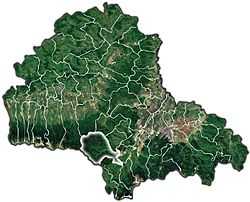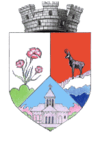Zărnești
| Zărnești | ||
|---|---|---|
| Town | ||
| ||
 | ||
 Zărnești | ||
| Coordinates: 45°34′N 25°20′E / 45.567°N 25.333°ECoordinates: 45°34′N 25°20′E / 45.567°N 25.333°E | ||
| Country |
| |
| County | Braşov County | |
| Status | Town | |
| Government | ||
| • Mayor | Dorel Valeriu Bârladeanu (SDP) | |
| Area | ||
| • Total | 204.75 km2 (79.05 sq mi) | |
| Population (2011) | ||
| • Total | 21,681 | |
| Time zone | EET (UTC+2) | |
| • Summer (DST) | EEST (UTC+3) | |
| Website | Website | |
Zărnești (Romanian pronunciation: [zərˈneʃtʲ]; German: Molkendorf, Zernescht; Hungarian: Zernest) is a town in Braşov County, Transylvania, Romania, with a population of 21,681. It administers one village, Tohanu Nou.
It is located near the Piatra Craiului Mountains, which are part of the Southern Carpathians mountains range. Its close proximity to the Piatra Craiului make it a common start point for tourists and hikers wishing to explore "The Piatra Craiului National Park".
History
| Historical population | ||
|---|---|---|
| Year | Pop. | ±% |
| 1956 | 6,673 | — |
| 1966 | 17,628 | +164.2% |
| 1977 | 23,288 | +32.1% |
| 1992 | 26,319 | +13.0% |
| 2002 | 26,520 | +0.8% |
| 2011 | 21,681 | −18.2% |
| Source: Census data | ||
During the Roman period, soldiers of the Legio XIII Gemina were buried in the territory that is modern day Zărnești. It is first mentioned in the year 1373 under the name Zârna and also referred to as "possessio regalis Zerne" in 1395. Other names that appeared after 1437 are Zerna, Villa Czerne, and Zernyest.
Modern day Zărnești developed in the same location as the historic one. The commune of Tohan, which is now part of the town, was first mentioned in the year 1294, and remains among the oldest settlements in Romanian which have kept their name and location unchanged.
In 1951, Zărnești was declared a town, of which Tohanul Vechi (Old Tohan) became a part of. In 1968, the commune of Tohanul Nou (New Tohan) was included in Zărnești proper.
Due to the topographical diversity of Zărneşti and surrounding area, agriculture became the primary occupation for its residents until not too long ago. Industrialization began sometime in the 1800s, with the construction of the paper manufacturing plant in 1852, then called Celuloza, now called Celohart - EcoPaper”[1]), and the weapons plant "6 Martie" in 1936. These projects turned Zărneşti from a predominantly rural to an urban town.
The town of Zărneşti developed largely in the communist era, bringing its population to 25,000 people, which contributed to the addition of a few neighborhoods of communist era blocs. After the [Romanian Revolution] of 1989, the plants closed, only to be sold piece by piece to private buyers.
Currently, Zărneşti has enjoyed a spike in tourism, relieving some of the pressure of unemployment which followed the revolution.
Name
The Romanian name "Zărnești" is a derivation from zârnă (Black Nightshade[2]), a word of Slavic origin (from Old Church Slavonic зрьно, grain) and suffix -ești.
Notable people
- Rareş Manea, Dimitru Frâncu and Ionuţ Găliţeanu, ski mountaineers, born in Zărneşti
- Traian Moşoiu, Romanian World War I-general, born in Tohanul Nou
- Ion Monea, Romanian boxing champion, born in Tohanul Vechi
Photo gallery
-

View of valley of Zărneşti
-
View of the Piatra Craiului mountains from Zărneşti
References
- ↑ "Celohart Zarnesti". Celohart Zărneşti. Retrieved 24 August 2008.
- ↑ Dicţionarul explicativ al limbii române (DEX), Academia Română, Institutul de Lingvistică "Iorgu Iordan", Editura Univers Enciclopedic, 1998; entry: zârnă


